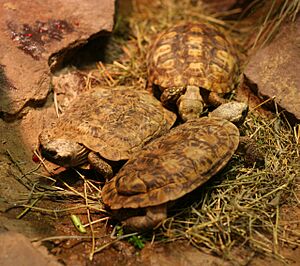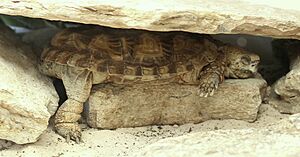Pancake tortoise facts for kids
Quick facts for kids Pancake tortoise |
|
|---|---|
 |
|
| Conservation status | |
| Scientific classification | |
| Genus: |
Malacochersus
|
| Species: |
tornieri
|
The pancake tortoise (Malacochersus tornieri) is a special kind of tortoise. It has a very flat shell, almost like a pancake! This tortoise is part of the family called Testudinidae.
You can find these unique tortoises in Tanzania and Kenya. There are also a few small groups living in northern Zambia. Their common name, "pancake tortoise," comes from their super flat shell.
Contents
What's in a Name?
The scientific name, tornieri, and another common name, Tornier's tortoise, are given in honor of a German zoologist named Gustav Tornier. He was a scientist who studied animals.
A Unique Tortoise Species
The pancake tortoise, Malacochersus tornieri, is the only member of its group, or genus. This means it's the only species like it in the world!
Meet the Pancake Tortoise
The pancake tortoise has a really unusual shell. It's thin, flat, and even a bit flexible. It can grow up to about 17.8 centimeters (7 inches) long. Unlike most other tortoises, whose shell bones are solid, the pancake tortoise has shell bones with many small openings. This makes its shell lighter and helps the tortoise move more quickly and easily.
The top part of its shell, called the carapace, is brown. It often has dark lines that spread out from each scute (shell plate). This pattern helps the tortoise blend in with its dry, rocky home. The bottom part of its shell, the plastron, is pale yellow with dark brown lines. Its head, legs, and tail are yellow-brown. Because of its unique, flat shape, this tortoise is very popular. Sadly, this popularity has led to too many being taken from the wild.
Where They Live and Their Home
The pancake tortoise is an East African species. It lives in southern Kenya and northern and eastern Tanzania. There might also be a group introduced in Zimbabwe. They have also been seen in Zambia.
These tortoises like to live on hillsides with rocky areas called kopjes. They prefer dry areas with thorn scrub (bushes with thorns) and savanna (grasslands with scattered trees). They can be found from about 30 meters (100 feet) to 1800 meters (6,000 feet) above sea level. Their home is a dry, semi-desert area. It has Acacia and Commiphora bushes, and Brachystegia woodland in higher places. They live in dry grasslands at low heights, especially on small rocky hills.
Life and Habits of the Pancake Tortoise
Pancake tortoises live in separate groups. Many of them might share the same rocky hill or even the same rock crack. During mating season, in January and February, male tortoises will fight to mate with females. Bigger males usually get more chances to mate.
Reproduction and Life Cycle
In the wild, females seem to lay eggs in July and August. However, in zoos, they can lay eggs all year round. The female digs a nest about 7.5 to 10 centimeters (3 to 4 inches) deep in loose, sandy soil. Usually, only one egg is laid at a time. But a female can lay several eggs over one season, with new eggs appearing every four to eight weeks. In zoos, the eggs hatch after four to six months. The baby tortoises are ready to live on their own as soon as they hatch.
Daily Life and Diet
Wild and captive tortoises often like to warm themselves in the sun. They don't seem to hibernate (sleep through winter). But some reports say they might aestivate (sleep through hot, dry periods) under flat rocks during the hottest months.
They are most active in the morning or in the late afternoon and early evening. Their main food is dry grasses and other plants. The pancake tortoise is a fast and good climber. It rarely goes far from its rocky home. If it feels threatened, it can quickly dash into the nearest rock crevice.
Amazing Defense Mechanism
Since this tortoise could easily be attacked by predators, it relies on its speed and flexibility to escape. It doesn't pull into its shell like other tortoises. Instead, its flexible shell allows it to squeeze into narrow rock crevices. This lets it use hiding places that other tortoises can't. Scientists have two ideas about how it wedges itself into these cracks. One idea is that it pushes a hard part of its shell against the top of the crevice using its back legs. Another idea is that it "inflates" a soft part of its bottom shell with air.
Threats and Protecting Them
The biggest dangers to the pancake tortoise are the destruction of its home and too many being taken for the pet trade. Because these tortoises don't have many babies, groups that have been taken from the wild can take a very long time to recover. New buildings and farms reduce the amount of good habitat for them. This habitat is already not very common. In Kenya, their thorn scrub homes are cleared for farming. In Tanzania, too many goats and cattle grazing also harm their habitat.
The pancake tortoise is listed as critically endangered on the IUCN Red List. This means it's at a very high risk of disappearing from the wild. It's also listed on Appendix I of Convention on International Trade in Endangered Species of Wild Fauna and Flora (CITES). This means international trade in these animals is almost completely banned.
In 1981, Kenya stopped the export of pancake tortoises unless special permission was given. Tanzania also protects this species under its Wildlife Conservation laws. It is protected inside the Serengeti National Park. The European Union banned importing the pancake tortoise in 1988. However, some trade with EU countries still happens. Good news is that the pancake tortoise has been bred in zoos. There is now a special program in European zoos to help them have more babies and grow their numbers.



